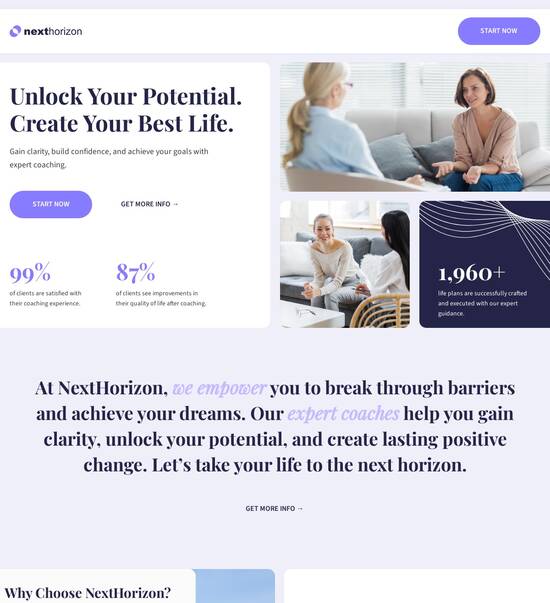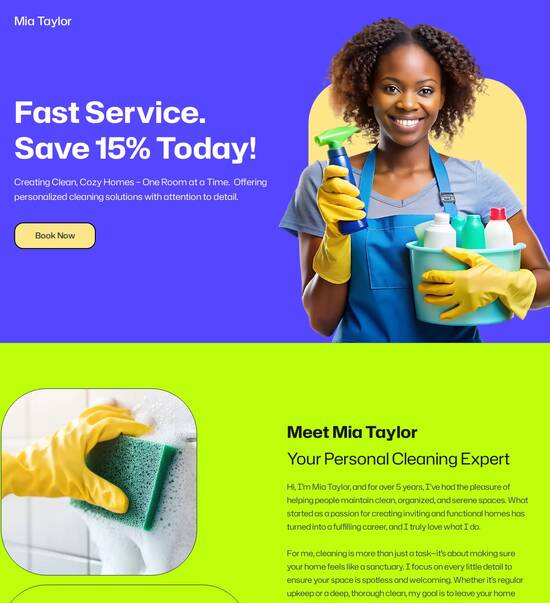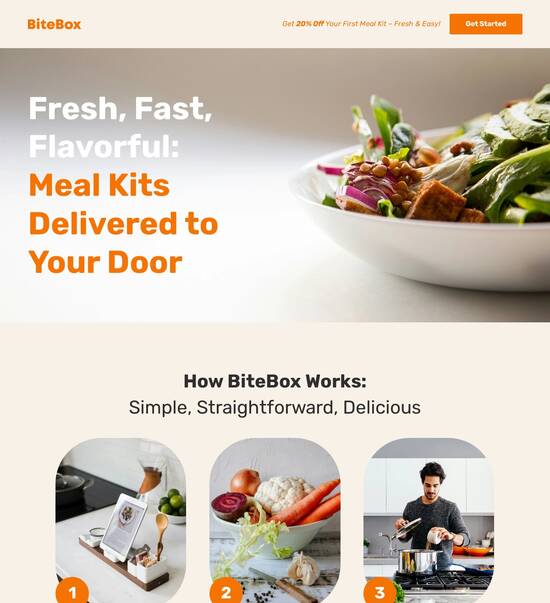
HTML page templates optimized for Mozilla Firefox
Explore Similar TemplatesAbout template
Try out HTML page templates optimized for Mozilla Firefox and reach your clients without breaking a sweat. Take a step forward with an intuitive and compliant solution.
Recommended templates

Easy to build without coding
With the intuitive drag-and-drop builder, anyone on your team can create high-converting pages without any knowledge of code or design. Make enhancements to your landing page with custom widgets using Javascript, HTML/CSS, or third-party scripts.

Multiple layouts for any industry and goal
Select from 500+ landing page layouts built to boost conversions across industry-specific scenarios. Customize them by adjusting fonts, adding images, and generating on-brand content with the AI assistant. Quickly scale with Instablocks® and Global Blocks that you can save, reuse, and update globally.

Loads fast and looks polished on any device
Every template is responsive, which means they present professionally on any device and load blazingly fast with our Thor Render Engine. You can also power them up with Google AMP technology to deliver an unparalleled mobile experience and drive higher conversions.

Robust analytics & experimentation
Get real-time updates and reporting across all your devices, showing the number of visitors, conversions, cost-per-visitor, and cost-per-lead. Launch AI-powered experiments, run A/B tests, and use heatmaps to analyze user behavior, then optimize your landing page to maximize conversions.







Easy to build without coding
With the intuitive drag-and-drop builder, anyone on your team can create high-converting pages without any knowledge of code or design. Make enhancements to your landing page with custom widgets using Javascript, HTML/CSS, or third-party scripts.
Multiple layouts for any industry and goal
Select from 500+ landing page layouts built to boost conversions across industry-specific scenarios. Customize them by adjusting fonts, adding images, and generating on-brand content with the AI assistant. Quickly scale with Instablocks® and Global Blocks that you can save, reuse, and update globally.
Loads fast and looks polished on any device
Every template is responsive, which means they present professionally on any device and load blazingly fast with our Thor Render Engine.
Robust analytics & experimentation
Get real-time updates and reporting across all your devices, showing the number of visitors, conversions, cost-per-visitor, and cost-per-lead. Launch AI-powered experiments, run A/B tests, and use heatmaps to analyze user behavior, then optimize your landing page to maximize conversions.
All the features you need to build form html moz
Explore more featuresLearn how to build html moz list
Frequently asked questions about firefox templates
Leading the way in building high-performing landing pages





Optimize html: Your ultimate how-to guide
Many marketing professionals focus on making high-quality content that underperforms due to relying on an old strategy. Include landing pages to your content strategy to reach your target audience, build trust, and push conversion rates. With Instapage, it is simple to produce personalized landing pages using our drag-and-drop builder and customizable web templates. Don’t settle for mediocre platforms - try out our HTML page template optimized for Mozilla Firefox to take your campaigns to the next level.
How our HTML page template optimized for Mozilla Firefox benefits you
Instapage is the best solution for SMBs and small teams who want to create innovation in their projects. Get more than 500 business-specific and adjustable landing page layouts. Alter, edit, and modify your page layout as you wish, no restrictions or past experience required. With Instapage, landing page design is completed in a matter of minutes, with the possibility to work together on the project with your teammates in real time. Quickly turn our HTML page template optimized for Mozilla Firefox into your breakthrough marketing campaign.
Quickly integrate your preferred marketing, CRM, and e-commerce apps into your daily workflows to increase efficiency and accuracy. Additionally, running A/B tests and using Instapage’s advanced analytics increases your chances of successfully launching your new projects or revising your existing content strategy. Reach your target audience without breaking a sweat with Instapage web templates. Begin your free Instapage trial today to forever transform how you strategy your digital marketing campaigns!
People also ask about html optimization
HTML page template optimized for Mozilla Firefox
Understanding HTML page templates optimized for Mozilla Firefox
In the web development landscape, ensuring your HTML page templates are optimized for Mozilla Firefox is crucial. As one of the leading browsers globally, Firefox is recognized for its commitment to web standards, user privacy, and innovative features. This guide will explore the significance of browser compatibility, specific features of templates tailored for Firefox, and strategies for development while considering the unique aspects of this popular browser.
The significance of browser compatibility in web development
Browser compatibility is a cornerstone of efficient web development. With numerous browsers available, each with distinct rendering engines, developers must ensure their pages load and function correctly across these platforms. Statistics show that as of late 2023, Firefox holds approximately 8.4% of the worldwide browser market share, establishing it as a significant player alongside other competitors such as Chrome and Safari. This diversity in browser usage requires web developers to prioritize cross-browser compatibility to cater to a broad audience.
Over 2 billion users rely on Firefox, highlighting the necessity for optimization.
Firefox's focus on privacy and security sets it apart from many other browsers.
A considerable portion of the developer community supports Firefox standards.
Mozilla has played a pivotal role in establishing and promoting web standards, encouraging a more uniform experience across different browsers. By adhering to these standards, developers ensure that their projects function seamlessly and reach a wider audience. This practice enhances user engagement while maintaining the integrity of content, making it essential for any successful web strategy.
Features of HTML page templates tailored for Firefox
Creating HTML templates specifically optimized for Firefox involves integrating several beneficial features. One of the most important aspects is responsive design, which enhances the user experience by allowing templates to adapt to various screen sizes. With varying device usage, including mobile phones and tablets, responsive design ensures users enjoy a consistent experience regardless of their device. One popular technique is the use of CSS Grid Layout, which enables developers to easily create complex responsive layouts.
Flexbox: A layout model that offers flexibility in aligning elements, perfect for responsive design.
Media Queries: Allow specific styles based on device characteristics, optimizing layout.
Viewport Units: Using 'vw' or 'vh' helps scale design elements proportionately.
Furthermore, Firefox supports advanced CSS techniques, facilitating richer designs without compromising on performance. CSS variables enable developers to manage styles more efficiently, while animations can be optimized to provide a smoother experience. Coupled with well-structured HTML, these elements result in visually appealing and functional web pages that elevate the user interaction to a new level.
Developing robust HTML templates for Firefox
To develop robust HTML templates for Firefox, it's essential to start with a clear and structured document outline. A well-formed HTML document starts with the doctype declaration, followed by the 'html', 'head', and 'body' elements. Each section must be explicitly defined using appropriate tags, ensuring semantic clarity and effective rendering by Firefox's engine.
DOCTYPE declaration to specify HTML version.
HTML, head, and body tags for structured layout.
Using header tags (H1, H2, etc.) for better SEO and readability.
A sample HTML structure showcases these best practices effectively. It's important to incorporate multimedia elements, alt attributes for images, and navigation menus using 'nav' elements, which contribute to the template's overall semantic quality. Addressing loading times is another vital area; efficient optimization techniques, like image compression, and utilizing CSS sprites can significantly enhance performance, ensuring that users have a smooth and fast experience.
Features unique to Mozilla Firefox
Mozilla Firefox provides several browser-specific features that can significantly benefit developers when optimizing HTML templates. Certain CSS properties, such as 'display: grid', work seamlessly in Firefox, allowing developers to create intricate layouts with ease. JavaScript libraries like 'three.js', which cater to 3D graphics, also perform exceptionally well in Firefox, enhancing interactive design features on the page.
CSS Grid Layout for advanced responsive designs.
WebAssembly support for faster execution of high-performance applications.
WebRTC for real-time audio and video communication.
However, relying on non-standard features may lead to compatibility issues with other browsers. Developers should always test their templates comprehensively to ensure that features function as expected across various platforms. This diligence can often result in more robust and reliable HTML templates that serve a wider audience while still capitalizing on Firefox's unique strengths.
The role of communities and collectives in template development
Communities play a crucial role in the development of HTML templates optimized for Firefox. Numerous platforms and forums provide developers with resources, support, and feedback that contributes to collective growth and knowledge sharing. Engaging with these communities can enhance understanding of browser-specific development and allow developers to tap into a pool of shared experiences and solutions.
Stack Overflow: A hub for developers to ask questions and share expertise.
Mozilla Developer Network (MDN): Extensive resources and documentation specific to Firefox.
GitHub repositories: Collaborate on projects and discover innovative approaches.
Utilizing collaborative tools is equally important for teams working on HTML templates. Platforms like Slack or Trello facilitate effective communication and project management, ensuring adherance to deadlines and quality standards. Documenting every decision and approach can also contribute to clarity in future project iterations, solidifying the successes and learnings from past endeavors.
Strategies for accessing comprehensive knowledge resources
Acquiring comprehensive knowledge about Firefox optimization often begins by exploring online learning platforms. Websites like Udemy and Coursera offer courses that help grasp the intricacies of HTML, CSS, and JavaScript, specifically focused on maximizing performance within Firefox. Whether you’re a newcomer or an experienced developer, these platforms provide tailored courses aimed at different skill levels, facilitating gradual skill development.
W3Schools: Offers free resources for beginners to advanced users on web technologies.
MDN Web Docs: Mozilla’s official documentation, essential for understanding HTML, CSS, and JavaScript.
YouTube channels focused on web development tutorials.
Leveraging documentation is a key element in mastering Firefox-specific capabilities. Mozilla’s developer documentation is extensive and provides detailed explanations and examples of features unique to Firefox. By exploring quality tutorials that delve into both basic and advanced techniques, developers can refine their skills more effectively.
Answering common questions on HTML templates
While developing HTML templates optimized for Firefox, several questions commonly arise regarding best practices for functionality and performance. Developers often inquire about how to ensure that their pages render accurately across different versions of Firefox or troubleshoot discrepancies. Utilizing Firefox Developer Tools can significantly aid in identifying issues while ensuring that pages meet standards. This allows for real-time adjustments that enhance the overall user experience.
What are the best practices for debugging pages in Firefox?
How to optimize images and multimedia for faster loading times?
What are popular resources for troubleshooting common issues?
Gathering user feedback is essential to understanding what works well in Firefox templates. Analyzing client perspectives on load times, visual layout, and overall usability provides developers with actionable insights. Regularly iterating on templates based on these findings ensures continuous improvement and adaptation to evolving user expectations.
Enhancing your HTML template's luck factor
Implementing A/B testing is a powerful strategy for optimizing HTML templates tailored for Firefox users. By comparing variations of a single page layout, developers can analyze which design or content configuration yields better performance metrics and user engagement. This feedback loop is invaluable in refining templates to align with user preferences, contributing to overall conversion improvements.
Define key performance indicators (KPIs) to measure success.
Use a tool like Google Optimize to set up A/B tests for different variations.
Review collected data and iterate on templates accordingly.
Moreover, tracking performance metrics using Firefox's built-in tools allows developers to monitor real-time data concerning load speeds and interactions. Analyzing this data equips developers with insights and facilitates informed decision-making regarding future enhancements, ensuring that templates remain competitive and user-friendly.
Future trends in HTML and Firefox development
The future of web technologies heavily influences Firefox's development trajectory, and staying abreast of these trends is crucial for developers. Emerging nuggets such as Progressive Web Applications (PWAs), enhanced JavaScript framework capabilities, and the continued evolution of CSS are shaping the future landscape of web development. Firefox, with its commitment to performance and user experience, is likely to incorporate these advancements, further optimizing the browsing experience.
Increased adoption of WebAssembly for high-performance applications.
Greater emphasis on privacy-focused web applications.
Innovations in accessibility features to cater to a broader audience.
Developers can encourage innovation through community engagement and collaboration, transforming the way templates are developed. Participation in hackathons, code sprints, and open-source projects allows teams to showcase creativity while addressing challenges that arise in template design. Continuous learning and adaptation remain paramount to succeeding in a rapidly changing digital landscape.
Ready to skyrocket conversions?
Supercharge your ad campaigns with high-performing landing pages
Get started














